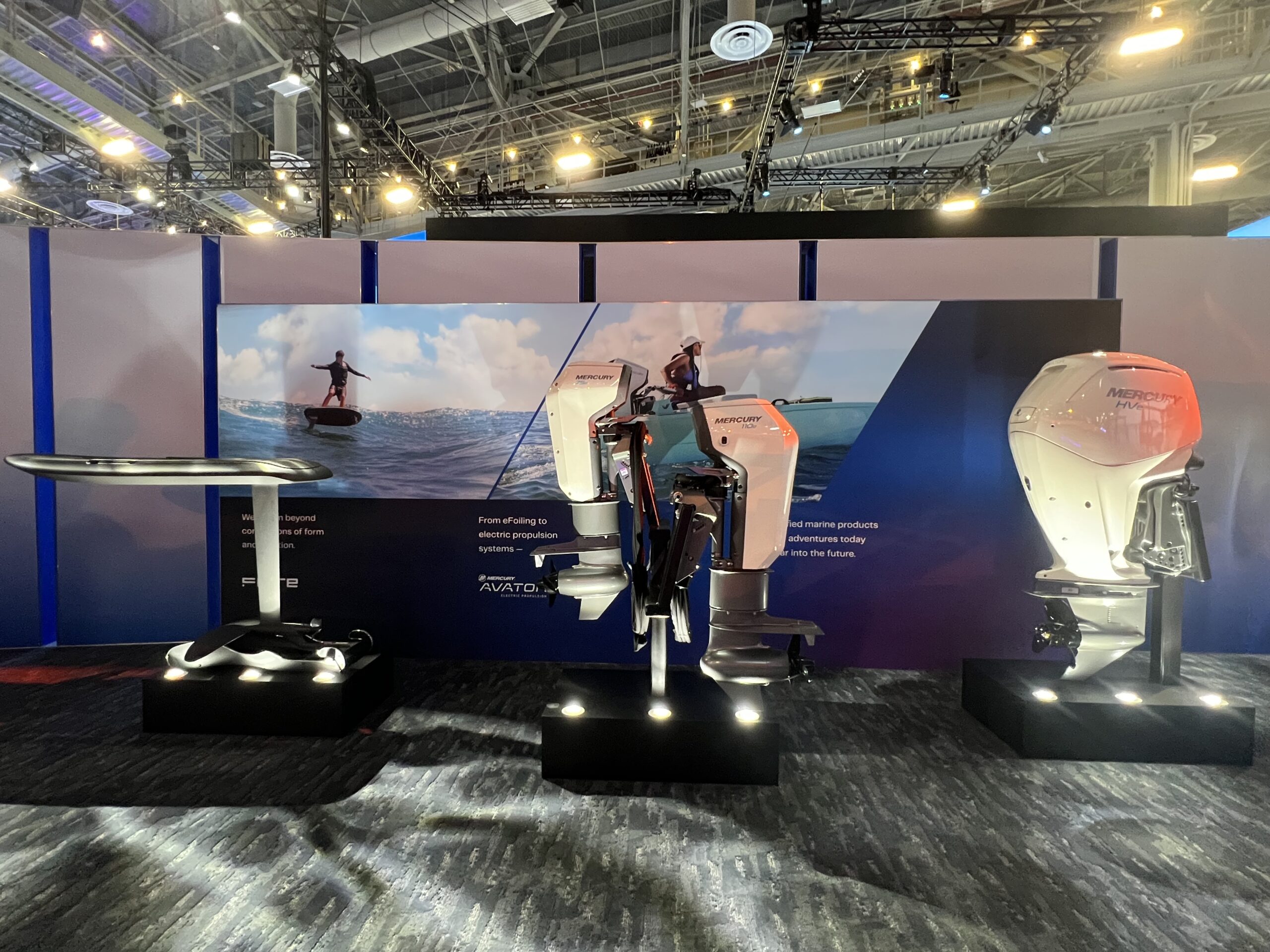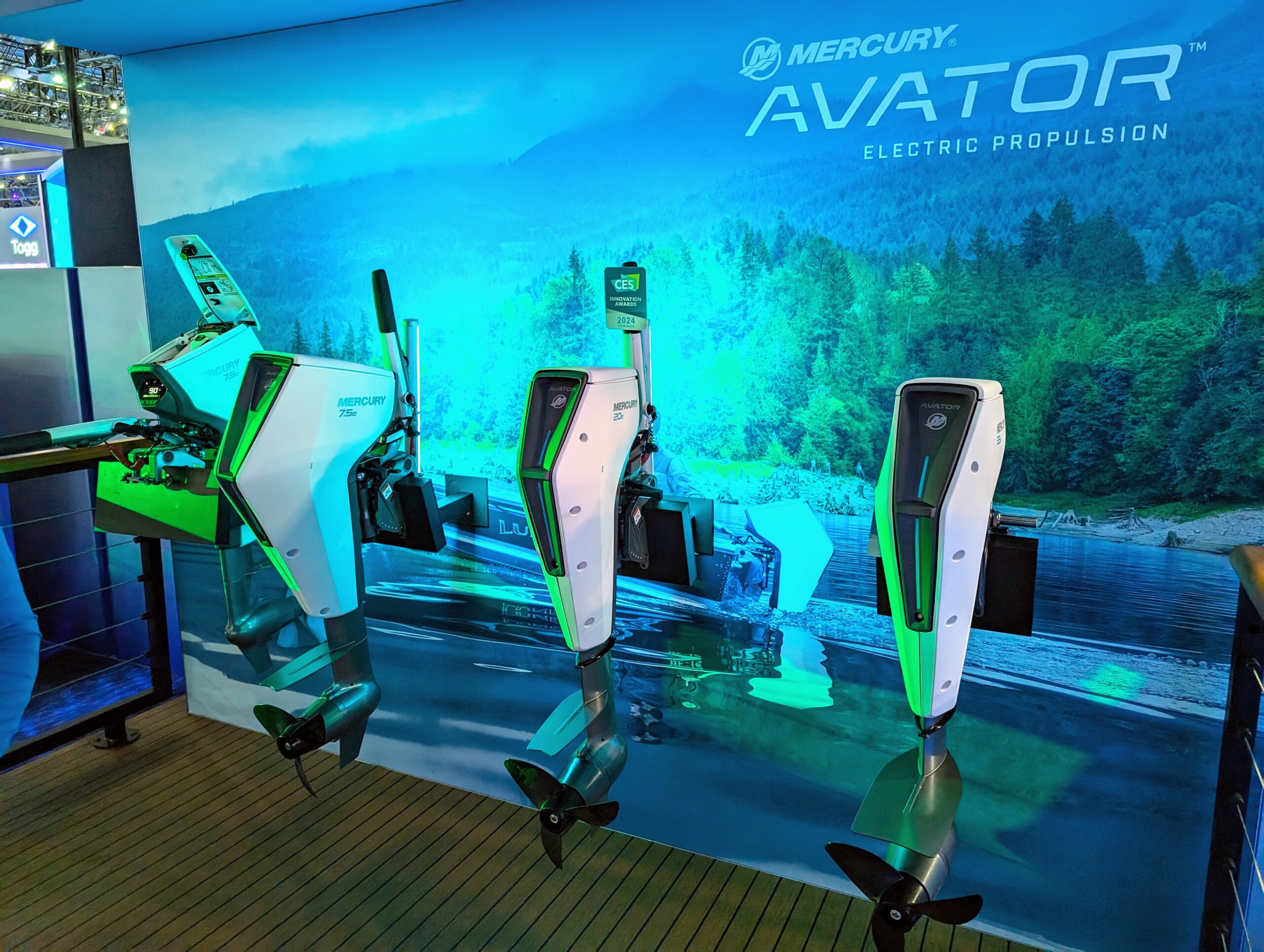Sign up for daily news updates from CleanTechnica on email. Or follow us on Google News!
Mercury Marine is launching an all out attack on the legacy boating propulsion industry with its revolutionary Avator electric outboard motor lineup.
At CES in 2023, Mercury Marine showed off the Avator 7.5e, a 750 watt outboard electric motor designed to be used on smaller vessels. Fast forward 12 months and Mercury Marine is back at CES this year with 5 different Avator electric outboard motors.
We spoke with Mercury Marine’s expert in electrification at CES 2024 and she unpacked all of the amazing technology for us from the ground up. All of Mercury Marine’s current electric motor options are 48 volt which includes both the motor and the batteries.

Looking at these electric motors, it’s clear there is a balance between the technology in the motor and the power and range expectations of traditional boaters using internal combustion engines. To support longer range travel, more batteries are needed which weighs down the boat, causing more drag. This drives the need for more batteries, etc.
It’s a lot like the struggle happening in electrified aviation today but instead of having to stay airborne with increasingly heavy loads, electric boats need to stay afloat. The sweet spot of power vs range will continue to evolve as motor efficiency and battery energy density improve over time.
As of right now, Mercury Marine believes it is pushing the limits of what’s possible with its current motor lineup though they are teasing a much larger high voltage package but they’re not sharing any official specs, voltage, power, or battery capacity at this point.
Applications
With these power ratings, Mercury Marine’s current electric motors are best suited for use in smaller applications like aluminum sided boats, bass boats, and other such small, localized applications. To ensure sufficient range, Mercury Marine paired its motors with battery capacity minimums that can support one hour of full throttle adventure.
Of course it’s not typical for boat owners to run at full throttle the entire time so they should expect a longer run time than just an hour. Real world performance and range will vary based on a number of conditions including the choppiness of the water, wind, temperature, etc, much like they do in the four-wheel variants of electric vehicles.

These electric motors can be dropped into place one-for-one in applications where combustion motors would otherwise have been used and offer tons of additional benefits that combustion motors simply can’t. First and foremost: noise. Electric motors are essentially silent and provide a much more pleasant experience compared to a combustion vehicle chugging along at the back of your boat, spewing out noxious fumes along the way.
A silent ride isn’t just beneficial for people, it’s also great for sneaking up on fish. Fishing from a boat with an electric motor is essentially silent, which is a stark contrast to combustion motors which make tons of noise, scaring fish away in the process.
A Range of Motors
They range from the Avator 7.5e all the way up to the all new Avator 110e that packs a whopping 11 kW of electric power. They’re even teasing a heavy duty electric version in their booth though they aren’t sharing any specs or pricing for it just yet. The Avator 7.5e features an integrated battery that snaps into place inside the shell of the outboard itself that when removed, weighs 17 lbs / 7.7 kgs. The removable battery pack keeps the motor light and makes the entire system portable.

All of the larger motors in the lineup require an external battery pack to get them moving. This was necessary to achieve Mercury Marine’s baseline target of giving each motor at least 1 hour of runtime at full throttle. Most boaters aren’t running full out so these combinations should deliver much more runtime than that in reality.
The larger 2.3 kilowatt-hour battery weighs 48 lb / 21.7 kgs and can be stacked up in series up to with up to four batteries supplying power to the motors.

Moving on up the product lineup, the Avator 20e pushes out 2,000 watts or just under three horsepower. It’s available as a tiller model with a handle to steer and provide throttle inputs or as an outboard motor with remote controls up front.
Mercury Marine went with transverse flux motors that are optimized for use in a marine environment, including special high thrust props that strike a balance between power output and efficiency. Electric motors push out max torque from a stand still and because of this, Mercury Marine claims the Avator 20e can accelerate a 12-foot Lund WC-12 boat at a similar rate as a 5hp four-stroke outboard.
Next up is the Avator 35e that can get a boat moving similar to what you’d experience with a 9.9hp four-stroke gas engine. It boasts a power output of 3,500 watts and must be connected to at least two of the 2,300 Wh battery packs. This requires the addition of a Power Station to connect multiple batteries to the motor which comes with the added benefit of providing a single charging port for up to four connected batteries at a time.

At CES this year, Mercury Marine launched the Avator 75e and 110e. These big boys are still puny compared to what you’ll find in a speed boat but they show how the Avator line continues to expand to even more power and even more sizes of boats. As their names imply, they push out 7,500 watts and 11,000 watts respectively. They require multiple batteries and can be kitted out with a full range of Power Stations, Remote Consoles, and the like.
All of these Avator motors can connect to Mercury Marine’s app on a smartphone to provide the owner with all sorts of extra information though an additional adapter is required to provide connectivity.
Pricing
On the pricing front, Mercury Marines’ Avator electric motors do command a premium price compared to comparable combustion motor package. This is largely due to the cost of batteries and the tech they’re putting into these fresh motors. As with any new technology, it takes time to recoup the up front expenses that went into developing them but over time, we should expect this to drop.
Overall
Who’s to say what’s to come in the future, but as of today it’s clear that Mercury Marine is serious about pushing into electrified technology and bringing its electric motors to even more customers and even more applications which with each passing day. This was a great first dipping for us into the world of electric marine motors and we’ll be watching to see it expand in the future.
We’re eager to see Mercury Marine continue to flesh out its lineup and look forward to the day we can head out on the lake or ocean in a fully electric boat that just might even have some solar panels up top to let it recharge from the sun above. Hey, a guy can dream, right?
The future is electric.
The future is now.
Have a tip for CleanTechnica? Want to advertise? Want to suggest a guest for our CleanTech Talk podcast? Contact us here.
Our Latest EVObsession Video
https://www.youtube.com/watch?v=videoseries
I don’t like paywalls. You don’t like paywalls. Who likes paywalls? Here at CleanTechnica, we implemented a limited paywall for a while, but it always felt wrong — and it was always tough to decide what we should put behind there. In theory, your most exclusive and best content goes behind a paywall. But then fewer people read it!! So, we’ve decided to completely nix paywalls here at CleanTechnica. But…
Thank you!
CleanTechnica uses affiliate links. See our policy here.




